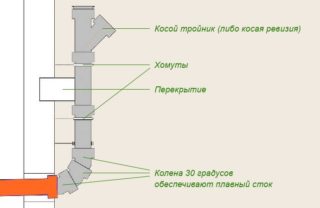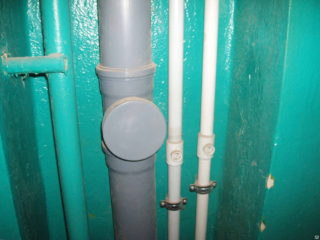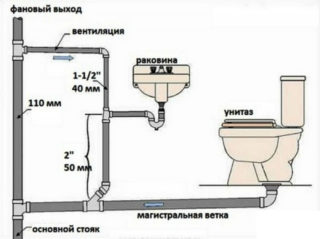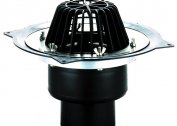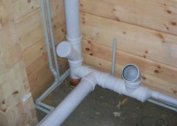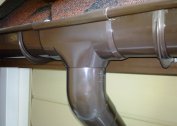Sewer risers in multi-storey buildings are classified as communal property, they are serviced by specialists from public utilities. They clean the pipeline if it is clogged, and repair if it leaks. However, the residents themselves need to monitor the condition of the risers in the apartments in order to timely detect the problem and call the craftsmen.
The device and purpose of the sewer riser
The sewer riser in an apartment building is designed to drain sewage. Includes five elements:
- the main vertical pipe made of cast iron or polymers;
- a cross at the bottom of the structure for connecting the toilet;
- a compensator, which is used in the transition from one type of pipe segment to another;
- audit for routine inspection and elimination of blockages;
- tee for connecting additional plumbing fixtures.
All these elements must be hermetically connected, so when you select them yourself to replace the device, it is important to choose the optimal ratio of the diameters of the parts.
The design in a private house is also equipped with a fan riser. This pipe section extends from the central sewer riser. It is taken to the roof of the building to remove unpleasant odors arising from a violation of the water seal. Cleaning the sewer does not save them.
Materials of manufacture
Previously, in most houses, cast-iron risers were installed - heavy, expensive and susceptible to corrosion. They were replaced by modern materials:
- Plumbing polymers. Products from them are distinguished by ease of installation and low weight, the impossibility of corrosion and a budget price. Compounds of parts are sealed with special gaskets, which eliminates the need for additional tools, for example, silicone.
- Ceramics. It is not easy to install such products, but they are immune to corrosion and plaque formation on internal surfaces.
- Steel with anti-corrosion coating. Metal structures are usually installed in private homes. They are convenient and inexpensive, but over time they still rust.
The best option are plastic models. If you choose the right angles in the horizontal sections of the structure, you can avoid plaque on the internal surfaces, as in more expensive ceramic products.
Section and size selection
The dimensions of the riser pipes depend on the area served and the types of plumbing fixtures connected:
- for small apartments with a limited number of plumbing fit pipe sections with a cross section of 100 mm;
- for bathrooms, kitchen appliances or bidets, highways with a cross section of 50 mm are selected, since only contaminated water goes into the drain;
- if the building is a high-rise building, the optimum pipeline section is from 15 cm.
It should be borne in mind that in the presence of a toilet, the outlet cross section should not be less than 100 mm. Over time, the internal diameter of the communications decreases due to plaque layers, so it is better to install products with a large cross section.
Installation Rules
You can replace the sewer riser even in a multi-storey building with your own hands. But if the work is carried out in a building where this part of the pipeline is not private, but common property, a work permit from the management company will be required. It is also necessary to warn the neighbors who own the apartments above and below about the overlap of the system. Even better is to completely change the risers with the whole staircase.
Replacing part of the sewage system only in your apartment:
- Dismantle the old part of the riser so that the pipe sections remain above and below. Cuffs are inserted into them.
- An adapter is installed on top, a tee on the bottom. The latter also needs to be equipped with a compression adapter. Joints should be as tight as possible to avoid leaks.
- Mount the clamps to secure the riser. With a ceiling height of less than 3 meters, three holders are sufficient: above, below and in the middle of the pipe.
- Connect all the elements and secure the riser with clamps.
Installation of the node is not particularly difficult. It is important that it is located behind the toilet and has a space of at least 4 cm to the wall.
Operation and maintenance
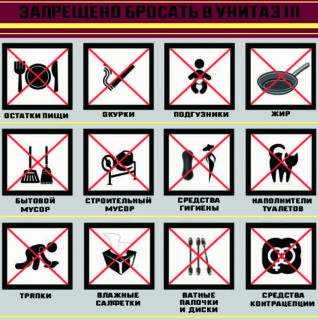 According to SNIPs, installation of revisions or cleaners is mandatory on the risers of apartment buildings. They are necessary for external and technical inspections. The first type of check must be carried out monthly by a specialist of the housing department. If minor problems are identified, they are immediately eliminated, complex problems are noted on the map for subsequent elimination.
According to SNIPs, installation of revisions or cleaners is mandatory on the risers of apartment buildings. They are necessary for external and technical inspections. The first type of check must be carried out monthly by a specialist of the housing department. If minor problems are identified, they are immediately eliminated, complex problems are noted on the map for subsequent elimination.
In-depth examinations are carried out twice a year - in spring and autumn. Based on their results, a decision is made on the current or overhaul.
Structural maintenance also involves prophylactic cleaning using a hydraulic and mechanical method to prevent blockages. In case of severe blockages, emergency cleanings are carried out.
The owners of apartments in apartment buildings themselves should also monitor the condition of the riser, inspect it for leaks and cracks and not throw objects that can clog the pipeline into the sewer.
